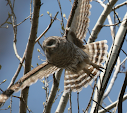
"Fate favors the prepared" - it is a quotation, or a maxim, or just a tried and true phrase.

Whatever its origins I was in a great position to see the validity of the statement yesterday. In some down time, I had for some unknown reason gotten to thinking about my repeated failures when photographing sunrises and sunsets. In my case the colors would just wash out, leaving me with hints of what I had seen.

I had made a few mental notes of a few tips and tricks during the day, and unexpectedly the sunset rewarded me with some brilliant colors.

I was out birding and was catching some gulls as the light softened. The memory card in my telephoto equipped camera - great for birding, horrible for landscapes or sunsets - had filled and I had started for home. Just as I was turning from east to south, and caught the view to the west the radio traffic copter woman commented on the brilliant approaching sunset. I had to agree, pulled off close to home, and filled another card on my other camera with experiments to capture the colors of the sky.

I learned a lot, and while I am far from having any actual proven formulas or techniques, I will offer these notes to myself or anyone else who has been frustrated by vivid sky colors. In Aperture Priority mode (Av), kick the Aperture value way up, and bump up the ISO value as well. I was trying shots from between 200 and 800. Then to compensate drop the Exposure Compensation, (Ev) back down below neutral. I also tried setting the WB to what I believe were the Shade and Cloud values, (haven't translated those icons back from my manual).

I was all over the place trying settings and the results varied. Because I stopped spur of the moment I didn't really jot down notes, and usually don't on photo settings, so I'll have to keep experimenting. At least I am on my way, and should enjoy the results more as I refine from here.
Another note, touching up sensor specs in sky pictures is just no fun! With bird shots I could usually crop to avoid the majority of them, and in the past year my Canon EOS 7D's sensor cleaner has made me forget just what a chore it can be. I will be cleaning off that sensor before any more sky shots, that's for sure! That being said, I am a huge fan of having the second camera body ready to go for scenery type shots. I don't generally carry it with me when hiking - I am doing well if I remember a point-and-shoot, but it is great to have in the bag on the way to and from work.













































